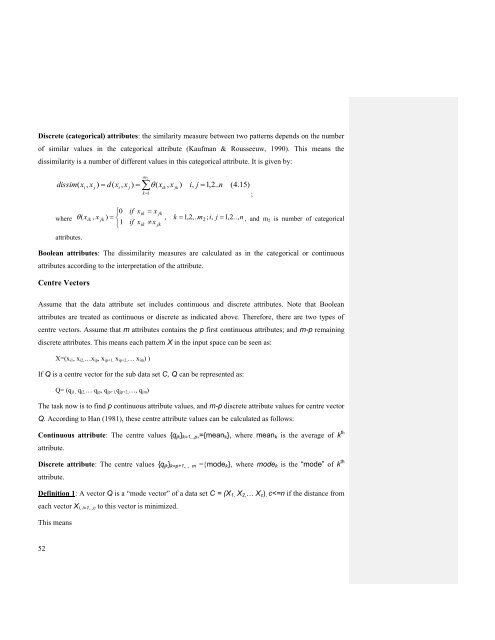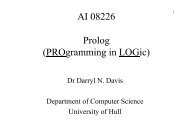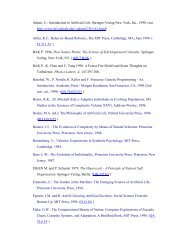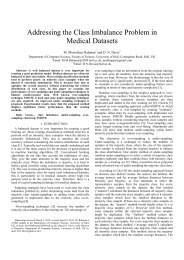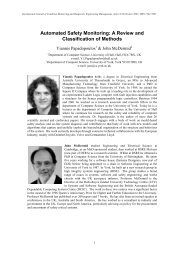just the Euclidian measurements of the K-means. These measures will be adequate for the mixture ofattribute types in the thesis data.4.3.2.1. Introduction <strong>and</strong> NotationsClustering analysis is a machine learning area of particular interest to pattern recognition data mining.The resulting data partition improves the data underst<strong>and</strong>ing, <strong>and</strong> reveals its internal structure.Clustering has been used in many application domains including biology, medicine, <strong>and</strong> so on, asindicated in Chapter 3. Further clustering applications can be seen in Dunham (2002); Berkhin (2002);Mirkin (2005).One well-known partition clustering algorithm is the K-means algorithm (Forgey, 1965; Jancey, 1966;MacQueen, 1967; Hartigan, 1975; Hartigan <strong>and</strong> Wong, 1979) which, according to Berkhin (2002), isthe most popular clustering tool used in scientific <strong>and</strong> industrial applications. The main duty of K-means is to partition n patterns in input space into k clusters such that similar patterns belong to thesame clusters; <strong>and</strong> dissimilar patterns will belong to alternative clusters.Assume that X is a pattern (observation, case, or patient record in data set). X typically consists of mcomponents: X= (x 1, x 2 ,…,x m ) = (x j ) j=1,..m . Note that each component in multidimensional space is anattribute (continuous or discrete) in the data domain. Therefore, we have a n m pattern matrix, wheren patterns {X i } i=1..n ; X i = (x i,1 , x i,2 ,.., x i,m ), <strong>and</strong> m attributes.Similarity MeasurementsA similarity measurement is the strength of relationship between two patterns in the samemultidimensional space. It can be represented as sim ij = sim(x i ,x j ), i,j= 1,2,.. n. According to Gower(1985), a similarity is regarded as a symmetric relationship. This means sim(x i ,x j )=sim(x j ,x i ).Contrastingly, dissimilarity measures of patterns have been introduced as the complement of similaritymeasures. A list of dissimilarity measures can be seen in Gower (1985). The dissimilarity measuresused in this thesis are as follows:Continuous attributes: the most common measure used is the Euclidean distance between twopatterns. It is given by:2dissim(x , x ) [ D(x , x )] ijijm1( x x2) , i,j 1,2..n(4.14)ik jkk 1,51where D is Euclidean distance, m 1
Discrete (categorical) attributes: the similarity measure between two patterns depends on the numberof similar values in the categorical attribute (Kaufman & Rousseeuw, 1990). This means thedissimilarity is a number of different values in this categorical attribute. It is given by:dissim(x , x ) d(x , x ) ijijm2k1(xik, xjk)i,j 1,2..n(4.15);0if xik x jkwhere ( xik , x jk ) , k 1,2,..m2;i,j 1,2..,n , <strong>and</strong> m1 if xikx2 is number of categoricaljkattributes.Boolean attributes: The dissimilarity measures are calculated as in the categorical or continuousattributes according to the interpretation of the attribute.Centre VectorsAssume that the data attribute set includes continuous <strong>and</strong> discrete attributes. Note that Booleanattributes are treated as continuous or discrete as indicated above. Therefore, there are two types ofcentre vectors. Assume that m attributes contains the p first continuous attributes; <strong>and</strong> m-p remainingdiscrete attributes. This means each pattern X in the input space can be seen as:X=(x i1 , x i2, …x ip , x ip+1, x ip+2, … x im ) )If Q is a centre vector for the sub data set C, Q can be represented as:Q= (q j1, q j2, … q jp , q jp+1, q jp+2, …, q jm )The task now is to find p continuous attribute values, <strong>and</strong> m-p discrete attribute values for centre vectorQ. According to Han (1981), these centre attribute values can be calculated as follows:Continuous attribute: The centre values {q jk } k=1,..p ,={mean k }, where mean k is the average of k thattribute.Discrete attribute: The centre values {q jk } k=p+1,.., m ={mode k }, where mode k is the “mode” of k thattribute.Definition 1: A vector Q is a “mode vector” of a data set C = (X 1, X 2, … X c ) , c
- Page 1 and 2:
THE UNIVERSITY OF HULLPredicting Ca
- Page 3 and 4:
3.4.2. Nonlinear Models ...........
- Page 5 and 6:
8.3. Mutual Information ...........
- Page 7 and 8:
List of FiguresFig. 3.1 Typical pat
- Page 9 and 10:
List of TablesTable 2.1The 11 facto
- Page 11 and 12:
Table 6.14 Alternative number of cr
- Page 13 and 14:
Table C12 Neural network results of
- Page 15 and 16: AbbreviationsNN(s): Neural Network(
- Page 17 and 18: Chapter 1 IntroductionThis thesis p
- Page 19 and 20: on. According to Bishop (1995), the
- Page 21 and 22: techniques is given. The standard c
- Page 23 and 24: A knowledge base that stores the in
- Page 25 and 26: This score is then compared to the
- Page 27 and 28: Cardiac signsRespiratory signsSysto
- Page 29 and 30: Given the ratings in Table 2.2, and
- Page 31 and 32: R11e3 z2Reg.No PATIENT_STATUS Physi
- Page 33 and 34: designed to their specific purposes
- Page 35 and 36: Chapter 3 Pattern Recognition3.1. I
- Page 37 and 38: algorithms depending on the request
- Page 39 and 40: a new patient. For example, t 5 can
- Page 41 and 42: And the strategy for pattern learni
- Page 43 and 44: Hence, whenever there is a specific
- Page 45 and 46: 3.4.2. Nonlinear ModelsDefinition:
- Page 47 and 48: vector machine are nonlinear models
- Page 49 and 50: From the confusion matrix in Table
- Page 51 and 52: the accuracy of 0.90 shows the trad
- Page 53 and 54: The comparison between neural netwo
- Page 55 and 56: Chapter 4 Supervised and Unsupervis
- Page 57 and 58: Therefore, the visualization of pat
- Page 59 and 60: A popular form of Gaussian basic fu
- Page 61 and 62: mj 1w ( x) b 0jj(4.7)where x is a
- Page 63 and 64: as an instance of the popular K-mea
- Page 65: o Update the weight as follows:w i
- Page 69 and 70: where d N (X i ,Q j ) is calculated
- Page 71 and 72: Zoo SmallThis data contains 101 cas
- Page 73 and 74: 1.20Discussions1.000.800.600.400.20
- Page 75 and 76: Chapter 5 Data Mining Methodology a
- Page 77 and 78: Raw dataDataselectingTarget DataPre
- Page 79 and 80: missing data”, the more detailed
- Page 81 and 82: Step 5 (Comparison/ Evaluation): Th
- Page 83 and 84: Missing values: The data includes 1
- Page 85 and 86: Scoring Risk Models: These are buil
- Page 87 and 88: The missing values for the “Heart
- Page 89 and 90: Data Filtering StageIn this step, t
- Page 91 and 92: Supervised ClassifiersThis section
- Page 93 and 94: 5.4. SummaryData mining is a partic
- Page 95 and 96: the significant level of 98.6% (P v
- Page 97 and 98: Attribute nameAttributetypeMissingv
- Page 99 and 100: Attribute nameAttributetypeMissingv
- Page 101 and 102: 6.4. Scoring Risk ModelsThe data fo
- Page 103 and 104: are nearly the same (12). The maxim
- Page 105 and 106: inconsistency between the linear an
- Page 107 and 108: epochs can help to reduce the over-
- Page 109 and 110: MSE (0.09). However, the model MLP_
- Page 111 and 112: suitable for the CM3aD data set wit
- Page 113 and 114: MethodA self organizing map tool is
- Page 115 and 116: The SOM algorithm is applied to the
- Page 117 and 118:
clustering models CM3aDC and CM3bDC
- Page 119 and 120:
clustering results, resulting from
- Page 121 and 122:
and CM3bD (KMIX and SOM) suggest th
- Page 123 and 124:
equivalent rates for “High risk
- Page 125 and 126:
25 input attributes to 16 input att
- Page 127 and 128:
7.2.4. Scoring Risk ModelsThis sect
- Page 129 and 130:
increasing number of patterns impro
- Page 131 and 132:
other words, there are negligible o
- Page 133 and 134:
ACCRand = PRand(true positive true
- Page 135 and 136:
Therefore, the poor clustering perf
- Page 137 and 138:
difficulty of measuring influential
- Page 139 and 140:
“High risk” predictions in "cli
- Page 141 and 142:
chosen by the user. The methods for
- Page 143 and 144:
average information content of the
- Page 145 and 146:
MI(X , Y) H(X ) H(X | Y) pi,j( x,
- Page 147 and 148:
number of patterns in class C i ; a
- Page 149 and 150:
The results in Figure 8.3 show that
- Page 151 and 152:
and the prediction risks reflects i
- Page 153 and 154:
Adding attribute weights to the clu
- Page 155 and 156:
system. Moreover, in POSSUM and PPO
- Page 157 and 158:
in scientific and industrial applic
- Page 159 and 160:
eing located in alternative risk ba
- Page 162 and 163:
and computer scientists, to verify
- Page 164 and 165:
Baxt, W. G. (1992). Use of an Artif
- Page 166 and 167:
Cristianini, N., Shawe-Taylor, J. (
- Page 168 and 169:
Hawkins, R.G., Houston, M.C., Ferra
- Page 170 and 171:
Kohonen, T. (1981). Self-organized
- Page 172 and 173:
Manning, C.D., Raghvan, P., and Sch
- Page 174 and 175:
Ohn, M. S., Van-Nam, H., and Yoshit
- Page 176 and 177:
Simelius, K., Stenroos, M., Reinhar
- Page 178 and 179:
Wang, K. Wang, L. Wang, D. and Xu,
- Page 180 and 181:
Appendix A. Data structureA.1. Hull
- Page 182 and 183:
A.2. Dundee siteThe following table
- Page 184 and 185:
B.2. Scoring Risk ModelsTable B2 sh
- Page 186 and 187:
The results are then divided to dif
- Page 188 and 189:
Attribute NameOriginal data Transfo
- Page 190 and 191:
AttributeName175Attribute TypeMissi
- Page 192 and 193:
Filtering task: The expected outcom
- Page 194 and 195:
Data is clustered by SOM Kmeans alg
- Page 196 and 197:
197 values of “C2H”. The model
- Page 198 and 199:
PATIENT_STATUS Boolean 0 Alive/Dead
- Page 200 and 201:
Cleaning and Transformation tasks:
- Page 202 and 203:
High riskLow riskCM3a-MLPCM3a-RBFCM
- Page 204 and 205:
Table C19: Experimental results of
- Page 206 and 207:
Therefore, the Mortality has got 25
- Page 208 and 209:
Both models CM3aC and CM3bC are use
- Page 210 and 211:
R1 PATECGAMBUL_STATUR1-A SIDEANTI_A
- Page 212:
Step 5 (Building New Models): The n


